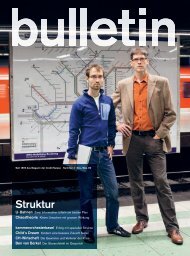Innovation
Global Investor Focus, 02/2007 Credit Suisse
Global Investor Focus, 02/2007
Credit Suisse
Create successful ePaper yourself
Turn your PDF publications into a flip-book with our unique Google optimized e-Paper software.
GLOBAL INVESTOR FOCUS <strong>Innovation</strong> — 30<br />
“The relationship between buyers and sellers<br />
is changing, because buyers are talking<br />
to each other in ever larger communities.”<br />
Niraj Dawar: A company must ask itself<br />
two questions: firstly, it needs to look at<br />
the interaction costs – what are the costs<br />
that customers need to incur to get value<br />
from us in order to derive the value of the<br />
product or services that they are purchasing<br />
from us? They are paying for the<br />
product, of course, however they are also<br />
incurring a large number of other costs.<br />
Going back to the Coca Cola can example,<br />
the customer has to carry the<br />
multipack home, break the bulk pack,<br />
refrigerate the product – all those are<br />
additional costs that well exceed the price<br />
the customer has paid for the product<br />
itself. But we can systemically reduce those<br />
interaction costs and thereby create<br />
value for the customer.<br />
There’s a second element to the “how.”<br />
Companies have to ask the question:<br />
what are the risks that the customer incurs<br />
in purchasing from us, rather than from<br />
our competitors? We can then systemically<br />
find the risks, make an inventory of the<br />
risks and eliminate them, so creating value<br />
for the customer.<br />
Is “how”-based innovation now a fundamental<br />
requirement?<br />
Niraj Dawar: Companies have access<br />
to the same outsourced R&D labs, outsourced<br />
designers and product developers,<br />
so product parity is increasingly a given.<br />
We’ve seen that with shortening product<br />
life cycles, intensified competitive activity<br />
in most industries, rapid imitation and<br />
innovation by competitors on the product<br />
side, companies are recognizing that<br />
competitive advantage may lie in the “how”<br />
rather than the “what.”<br />
How is the relationship between sellers<br />
and buyers changing?<br />
Niraj Dawar: It’s changing in many<br />
ways, but it’s changing not necessarily<br />
because of the “what” and “how.” It’s<br />
changing because buyers are more-thanever<br />
talking to each other in larger communities.<br />
They know what’s happening in<br />
other parts of the marketplace. Buyers<br />
are creating a large part of the information<br />
around products. By interacting on the<br />
Internet they can share that information.<br />
They are forming into communities. So<br />
where earlier the manufacturer or seller<br />
could speak to millions of consumers from<br />
on high, today the seller has to see<br />
itself not as a broadcaster of messages to<br />
millions of consumers, but rather as a<br />
member of a community in which they<br />
have a voice – though no more of a voice<br />
than others in that community. As members<br />
of that community they have to abide<br />
by the rules and the results tend to be<br />
increasingly monitored by consumers rather<br />
than firms. So yes, the relationship is<br />
changing, but because of larger changes<br />
occurring in the marketplace.<br />
Why do product innovations provide firms<br />
with little sustained advantage?<br />
Niraj Dawar: Technology is moving<br />
very fast. Somebody who develops the<br />
technology wants markets for it as quickly<br />
as possible and the reason they want to<br />
reach the market is that they know there<br />
are competitors ready to put similar<br />
products on the market as soon as they<br />
see that the product is successful. So the<br />
rate at which competitive products appear<br />
on the market and slice away market<br />
share is increasing. The result is that we<br />
have shorter periods of exclusivity. In other<br />
words, competitive advantage is more<br />
difficult to sustain than 15 years ago.<br />
An explosive impact<br />
Companies need to understand that the focus of their activities should not be<br />
what they sell, but rather what the customer buys, says Niraj Dawar. This subtle<br />
shift in perspective can yield tremendous insight into customer value.<br />
“Orica, an Australian explosives company, is a prime example. It completely<br />
changed the nature of what it sells by re-pricing a commodity product.<br />
It changed from selling explosives by the kilogram to selling a certain outcome<br />
– saying that, for example, 80% of the output of this explosion will be<br />
within the tolerances the customers specified in terms of rock size. That<br />
changed the rules of the game, and competitors now have to figure out what<br />
leads to certain outcomes of explosions.”<br />
Says Dawar: “Orica generated this innovation by collecting data from<br />
customers, collating that information and determining the conditions that<br />
produced desired outcomes. This put it in a position to take charge of the<br />
entire blast – not just sell commodity plastic – and offer customers contracts<br />
for broken rock. That is an innovation where management changed the pricing,<br />
but it also changed just about everything else except the product. That remained<br />
the same.”

















